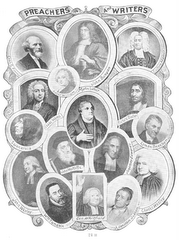End of the World - The Director's Cut
With all this talk going on right now about the end times, I thought it would be appropriate to put up a listing of the different beliefs about the Antichrist. I would also encourage you to read Scott Hill's post at Fide-O on his take of how the church is reacting to current events. Also there is a great new book out by Kim Riddlebarger called The Man of Sin: Uncovering the Truth about the Antichrist, I will warn you though he is a "Reformed Amillennialist", so you have to keep that in mind when reading.
Different Perspectives on the Doctrine of the Antichrist
Church Fathers
(Irenaeus, Hippolytus)
Time of Antichrist Appearing: Many antichrists (false teachers) will appear, but the Antichrist is yet future.
Distinctive Emphases: Antichrist will be an apostate Jew and false Messiah. He will appear after the fall of the Roman Empire in a rebuilt temple in Jerusalem.
Dispensationalism
(John Walvoord, Hal Lindsey, Tim LaHaye)
Time of Antichrist Appearing: Many antichrists (false teachers) will appear, but the Antichrist is yet future.
Distinctive Emphases: Antichrist appears during the seventieth week of Daniel after the rapture (see Dan. 9:24-27) and makes a peace treaty with Israel at the beginning of the seven-year tribulation period. He reveals his true identity in a rebuilt temple in Jerusalem by betraying Israel.
Historicism
(Reformers, Westminster Confession of Faith)
Time of Antichrist Appearing: Antichrist is identified with the papacy.
Distinctive Emphases: The temple mentioned by Paul in 2 Thessalonians 2:4 is a reference to the church, not the Jerusalem temple. The harlot Babylon (Revelation 17) is a reference to the Roman Catholic Church.
Preterism (B.B. Warfield, Ken Gentry)
Time of Antichrist Appearing: Many antichrists (False teachers) present throughout the course of this age. The beast of Revelation 13 was Nero and the book of Revelation depicts events of the first century that are already largely fulfilled.
Distinctive Emphases: Jesus Christ returned in judgment upon Israel in AD 70, closing out the end of the Jewish age. When Paul refers to the temple in 2 Thessalonians 2:4, he is referring to the Jerusalem temple, which was destroyed in AD 70.
Reformed Amillennialism
(Geergardus Vos, Anthony Hoekema)
Time of Antichrist Appearing:Many antichrists (false teachers) appear throughout the course of this age. A final Antichrist is yet to come in the form of state-sponsored heresy and the persecution of the church.
Distinct Emphases: The temple mentioned by Paul in 2 Thessalonians 2:4 is a reference to the church, not the Jerusalem temple. Antichrist’s appearance is tied to a time of great apostasy (cf. Rev. 20:1-20)
















4 comments:
Where does Warfield teach that Christ returned in 70 A.D. I would like very much to have that reference, if you can provide it. Thank you for your time.
This link will more than answer you question on Dr. Warfield.
http://www.preteristarchive.com/StudyArchive/w/warfield-benjamin_apocalypse.html
Thank you for the link, Nick. I read the quotes offered and I found a problem with the interpretation that has seemingly been given of them. First of all, Warfield's view that the "Man of Sin" is equivalent to the line of Roman Emperors beginning with Nero would place the appearance and continued existence of the "Man of Sin" long after 70ad. Wouldn't this imply that Warfield did not actually believe that Christ could have returned, spiritually or otherwise, at the presumed date of 70ad? Any reference to the date of Christ's return is, in fact, noticeably absent from any of the quotes offered.
I was under the impression, in fact, that Warfield did not handle Christ's references to what would befall "this generation" in anything like the usual preterist fashion, although I may be wrong about that. I would welcome any correction if that is not so.
In the meantime, I'm not sure why Warfield, from the quotes you offered me, would have to have held anything other than a certain form of postmillenialism.
Could you explain what I might have missed, then? Why do you list him as certainly among preterists of the past? Again, thank you for your time and efforts.
The information I have is from Kim Riddlebarger's book - The Man of Sin, and you can direct the question to him. His research is extremely extensive and i don't have the time to post it all here.
This the link to ask him a question.
http://kimriddlebarger.squarespace.com/contact-me/
Post a Comment